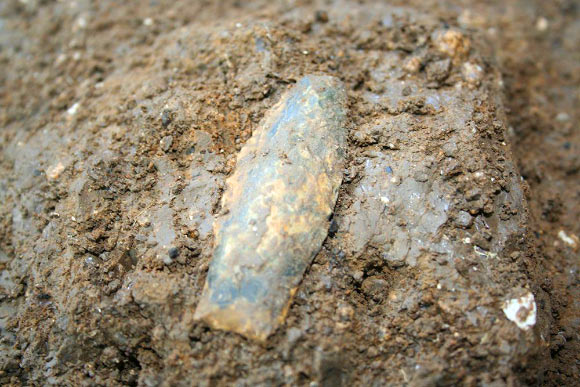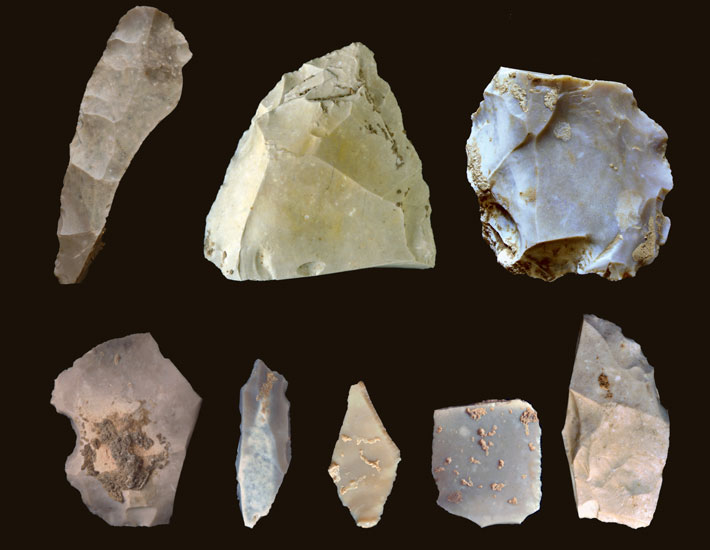Watching or reading the news you will occasionally come across stories where even a well educated journalist seems to be baffled about whether the topic of the story is Paleontology or Archaeology. After all, both sciences deal with the past, both dig up their evidence from the ground and it seems like much of that evidence consists of bones. Not only that, but there is without doubt a small but very important region of overlap between the two disciplines. So it’s easy to understand how non-experts can get confused.
The big difference between the two sciences is us, human beings. Archaeology deals with the human past, not only human remains but the remains of our activity. Material objects, anything from small tools to entire buildings are just as important to Archaeology as are human bones.

The subjects of Paleontology on the other hand are all of the creatures that ever lived on this Earth, right back to the very earliest living cell. In some sense therefore Archaeology is a subset of Paleontology. We are still living creatures after all. However the enormous range of material objects left by humans is so large and so unlike the remains of other living things that the two sciences operate in two completely different ways.
The first story I’d like to discuss illustrates this difference by showing how much archaeologists can learn from an ‘artifact’, a tool made thousands of years ago. In this case the tool is a stone spear point made by the earliest inhabitants of the Western Hemisphere in the region now known as Texas.

The Debra L. Friedkin archaeological site outside of Salado Texas has been excavated by researchers from Texas A&M University for more than a dozen years now. The remains here are some of the earliest evidence of human habitation in the Americas dating back some 15,500 years. These remains predate the classic Clovis remains first found in nearby New Mexico.

That makes the Friedkin site very important because for decades the Clovis culture, first described in the 1920s from digs outside of the town of Clovis New Mexico, were thought to be the remains of original people who came to the Americas about 13,000 years ago. In the years that followed numerous sites in both North and South America were found that produced artifacts consistent with Clovis culture.
Over the last twenty years however a few sites have been discovered that date several thousand years older than the Clovis sites. So far however these sites have only produced a small number of artifacts, making it difficult to determine whether or not these people were earlier examples of the Clovis culture, or do they represent an entirely new, unknown people.
Texas A&M Professor Michael Waters thinks that the Friedkin site can provide that answer, and in his opinion they are an entirely new people. The artifacts discovered by Professor Waters and his team even include the earliest known stone spearheads, see image above.
“The dream has always been to find diagnostic artifacts such as projectile points that can be recognized as older than Clovis and this is what we have at the Friedkin site.” Waters says. Whether or not other Archaeologists will accept Professor Waters’s conclusions remains to be seen but with each piece of evidence the answer becomes clearer.
Now in that story we were only talking about artifacts, that is objects manufactured by human beings. In this next story the evidence will consist solely of the actual remains of living creatures. So that means this story comes from the science of Paleontology. Also, where the story from Texas dealt with evidence that was fifteen thousand years old, the evidence in this story is over 400 million years old!

The first animals to possess a backbone and an internal skeleton, the first vertebrates that is were fish, although very strange looking fish they were. The earliest fossils date from about 480 million years ago but such fossils are few in number and show little diversity. Vertebrates were a small, not very successful group of animals. About 60 million years later however the fossil record explodes with numerous new species of fish suddenly appearing.

In their search for the explanation of how this explosion of vertebrates happened Paleontologists have looked to find out where this explosion happened. That is, did the diversification of fishes occur in the open ocean or perhaps it occurred around the ancient coral reefs of that period.
Now a new study proposes a different solution. Paleontologists Lauren Sallan of the University of Pennsylvania and Ivan J. Sansom of the University of Birmingham have generated a database of 2,728 specimens of fossil fish from around 420 million years ago. In particular the database records the environmental conditions of where the fossil animal lived.
“The Nice thing about the fossil record,” according to Sallan. “Is that we often find fishes in the context of where they lived. The rock that holds them tells us what their environment looked like, whether it was reef, shallow water, deep water, a riverbed or a lake.”
What Professors Sallan and Sansom have found is that the explosion of fish species occurred in the shallow waters right up near the shore, between the reefs and the beach. In this environment these early fish acquired adaptations, such as bottom dwelling, that later enabled them to fit into niches in both the coral reefs and deeper more open waters.
Living near the shoreline also allowed fishes to adapt to freshwater more quickly and more successfully than other major groups of animals such as the arthropods and mollusks. And there was one more adaptation that that occurred at this time which gave these early vertebrates a distinct advantage. This was when fish first acquired jaws!

So there you have it. Two examples of new research, one from the science of Archaeology, the study of humanity’s past, the other Paleontology, the study of life’s past.
